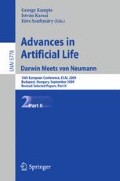Abstract
The leader election problem is a crucial problem in the theory of distributed algorithms, multi-agent systems as well as in sociobiology. In this paper we investigate one-dimensional binary state cellular automata with an intention to track self-organizational mechanisms that finally enable a global leader to be elected. Since our model is anonymous and uniform we also have to deal with a problem of symmetry that in great majority of cases is broken by inhomogeneity of arbitrary initial configurations. Our approach to the problem is based on the evolution of cellular automata by genetic algorithms and the methodology of computational mechanics. The presented new solution of the leader election reaches remarkably high performance of 94 − 99%. The analysis shows a sophisticated collective computation demonstrated by so called particles and their interactions. Due to the simplicity of our model, presented approach is general and universal enough to be applicable even at the level of primitive biological or artificial societies.
Access this chapter
Tax calculation will be finalised at checkout
Purchases are for personal use only
Preview
Unable to display preview. Download preview PDF.
References
Érdi, P.: Complexity explained. Springer, Heidelberg (2007)
Neumann, J.V.: Theory of self-reproducing automata - edited and completed by Burks. Illinois Press, Urbana (1966)
Smith, A.R.I.: Two-dimensional formal languages and pattern recognition by cellular automata. In: Proceeding of the 22nd Annual IEEE Symp. of Foundations of Computer Science (FOCS), pp. 144–152. IEEE Press, Los Alamitos (1971)
Mitchell, M., Crutchfield, J.P., Das, R.: Computer science application: Evolving cellular automata to perform computations. In: Bck, T., Fogel, D., Michalewicz, Z. (eds.) HandBook of Evolutionary Computation. Oxford University Press, Oxford (1997)
Crutchfield, J.P., Mitchell, M., Das, R.: Evolutionary design of collective computation in cellular automata. In: Evolutionary Dynamics: Exploring the Interplay of Selection, Accident, Neutrality, and Function, Oxford, pp. 361–411 (2003)
Mitchell, M.: An introduction to genetic algorithms. MIT Press, Cambridge (1996)
Crutchfield, J.P., Hanson, J.E.: Turbulent pattern bases for cellular automata. Physica D 69(3/4), 279–301 (1993)
Conradt, L., Roper, T.J.: Consensus decision making in animals. Trends in Ecology & Evolution 20(8), 449–456 (2005)
Lusseau, D., Conradt, L.: The emergence of unshared consensus decisions in bottlenose dolphins. Behavioral Ecology and Sociobiology (2009)
Sueura, C., Petit, O.: Shared or unshared consensus decision in macaques? Behavioural Processes 78(1), 84–92 (2008)
Nagpal, R.: A catalog of biologically-inspired primitives for engineering self-organization. In: Di Marzo Serugendo, G., Karageorgos, A., Rana, O.F., Zambonelli, F. (eds.) ESOA 2003. LNCS (LNAI), vol. 2977, pp. 53–62. Springer, Heidelberg (2004)
Lawrence, P.A.: The Making of a Fly: The Genetics of Animal Design. Wiley-Blackwell, Chichester (1992)
Knoester, D.B., McKinley, P.K., Ofria, C.A.: Using group selection to evolve leadership in populations of self-replicating digital organisms. In: Proceedings of the 9th Annual Conference on Genetic and Evolutionary Computation, pp. 293–300. ACM, New York (2007)
Angluin, D.: Local and global properties in networks of processors. In: STOC 1980: Proceedings of the Twelfth Annual ACM Symposium on Theory of Computing, pp. 82–93. ACM, New York (1980)
Frederickson, G.N., Lynch, N.A.: Electing a leader in a synchronous ring. JACM 34(1), 98–115 (1987)
Crutchfield, J.P.: The calculi of emergence: Computation, dynamics and induction. Physica D 75, 11–53 (1994)
Author information
Authors and Affiliations
Editor information
Editors and Affiliations
Rights and permissions
Copyright information
© 2011 Springer-Verlag Berlin Heidelberg
About this paper
Cite this paper
Banda, P. (2011). Cellular Automata Evolution of Leader Election. In: Kampis, G., Karsai, I., Szathmáry, E. (eds) Advances in Artificial Life. Darwin Meets von Neumann. ECAL 2009. Lecture Notes in Computer Science(), vol 5778. Springer, Berlin, Heidelberg. https://doi.org/10.1007/978-3-642-21314-4_39
Download citation
DOI: https://doi.org/10.1007/978-3-642-21314-4_39
Publisher Name: Springer, Berlin, Heidelberg
Print ISBN: 978-3-642-21313-7
Online ISBN: 978-3-642-21314-4
eBook Packages: Computer ScienceComputer Science (R0)

